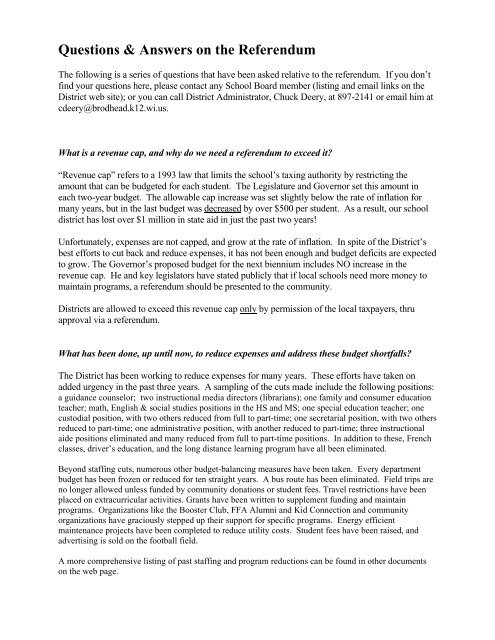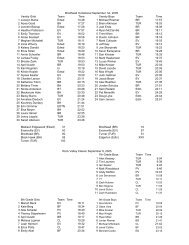Questions & Answers on the Referendum - Brodhead School District
Questions & Answers on the Referendum - Brodhead School District
Questions & Answers on the Referendum - Brodhead School District
- No tags were found...
Create successful ePaper yourself
Turn your PDF publications into a flip-book with our unique Google optimized e-Paper software.
While it’s sometimes possible to reduce staff, and we have d<strong>on</strong>e so, it’s not always as simple as it<br />
looks. With 100 fewer students, it might seem that three or four teachers could easily be eliminated.<br />
Unfortunately, those students are spread across 14 grades (4K-12), and <strong>the</strong> decline in enrollment<br />
<strong>on</strong>ly rarely reduces <strong>the</strong> size of any <strong>on</strong>e grade enough to eliminate a teaching positi<strong>on</strong>. Occasi<strong>on</strong>ally<br />
it works out where this is possible, and we have reduced to three secti<strong>on</strong>s in many grades.... but, it<br />
doesn’t always work out that way. We have, however, eliminated eight teaching positi<strong>on</strong>s in <strong>the</strong><br />
past three years, as well as cutbacks in administrati<strong>on</strong> and support staff.<br />
I’ve heard claims that <strong>Brodhead</strong> is “top-heavy” <strong>on</strong> administrati<strong>on</strong>. How does <strong>the</strong> district<br />
compare to o<strong>the</strong>r districts our size?<br />
Budget cuts have resulted in <strong>the</strong> eliminati<strong>on</strong> of <strong>on</strong>e administrative positi<strong>on</strong> (curriculum director<br />
combined with <strong>the</strong> MS Principal’s duties), and ano<strong>the</strong>r positi<strong>on</strong> has been reduced to part-time.<br />
<strong>Brodhead</strong> is quite average in its level of administrative staff when compared with o<strong>the</strong>r districts of<br />
its size. Yes, we have more administrators than our much smaller neighbors, Juda and Albany. We<br />
also have fewer administrators than our larger neighbor, M<strong>on</strong>roe. Am<strong>on</strong>g districts similar in size<br />
and compositi<strong>on</strong> to <strong>Brodhead</strong>, like our Rock Valley c<strong>on</strong>ference members, our administrative<br />
staffing pattern is comm<strong>on</strong>. One notable difference is that many of <strong>the</strong>se districts have an assistant<br />
principal working in <strong>the</strong>ir high school and/or middle school. Instead of an assistant principal, we<br />
have an instructi<strong>on</strong>al aide (paid at aide wages ra<strong>the</strong>r than an administrative-level salary) covering<br />
those duties and staffing an in-school suspensi<strong>on</strong> and mentorship room. The web site provides a<br />
worksheet comparing administrative positi<strong>on</strong>s across Rock Valley C<strong>on</strong>ference schools.<br />
Why doesn’t <strong>the</strong> <strong>District</strong> just spend it’s “slush fund” to fix <strong>the</strong> budget deficit, ra<strong>the</strong>r than<br />
presenting a referendum?<br />
The term “slush fund” is misleading and inappropriate, and likely refers to <strong>the</strong> <strong>District</strong>’s “fund<br />
balance”. This is an accounting term, identifying <strong>the</strong> <strong>District</strong>’s positive balance of assets over<br />
liabilities at <strong>the</strong> end of each budget year <strong>on</strong> June 30 th .<br />
The <strong>District</strong>’s fund balance is expected to end <strong>the</strong> current budget year at $2.4 milli<strong>on</strong>, or just over<br />
22% of our annual budget. It is <strong>the</strong> Board’s intenti<strong>on</strong> to spend down some of this balance to retire<br />
debt, and to use it to cover <strong>the</strong> shortfall between anticipated deficits and <strong>the</strong> lower amount of funds<br />
requested in <strong>the</strong> referendum.<br />
The main purpose of <strong>the</strong> fund balance is cash flow. Let’s compare it to your household finances.<br />
The <strong>District</strong> gets its m<strong>on</strong>ey from local property taxes and state aid, much like you draw a paycheck.<br />
Unlike a paycheck that you get m<strong>on</strong>thly or bi-weekly, <strong>the</strong> <strong>District</strong> gets its m<strong>on</strong>ey at irregular points<br />
during <strong>the</strong> year, most of <strong>the</strong>m later in <strong>the</strong> budget year. The fund balance carries <strong>the</strong> <strong>District</strong> between<br />
those payments. Like your home checkbook account, <strong>the</strong> <strong>District</strong>’s fund balance is highest <strong>on</strong> <strong>the</strong><br />
day right after it receives payments from property tax or state aid (pay day for your account). As<br />
<strong>the</strong> m<strong>on</strong>th progresses, you spend down that checkbook balance until it is probably nearly empty <strong>on</strong><br />
<strong>the</strong> day before payday. In a similar fashi<strong>on</strong>, <strong>the</strong> <strong>District</strong>’s fund balance is actually near zero at some<br />
points during <strong>the</strong> year.
Without this fund balance, or if <strong>the</strong> fund balance gets too small, <strong>the</strong> <strong>District</strong> would have to take out<br />
loans to pay its bills between <strong>the</strong> aid payments. That approach would mean spending valuable tax<br />
dollars <strong>on</strong> interest expenses for <strong>the</strong> borrowing... m<strong>on</strong>ey that can be better spent <strong>on</strong> our children.<br />
Is class size really a serious issue?<br />
Simple logic would tell us that having fewer children sharing <strong>the</strong> teacher's attenti<strong>on</strong> would make<br />
a better educati<strong>on</strong>al envir<strong>on</strong>ment for all. Having fewer peers to compete with should also<br />
improve a child's social development. But, is <strong>the</strong>re data to support <strong>the</strong> importance of smaller<br />
class sizes? Yes....<br />
Wisc<strong>on</strong>sin's SAGE program (Student Achievement Guarantee in Educati<strong>on</strong>) helps schools<br />
achieve smaller class sizes, and has been in place for over ten years. Research <strong>on</strong> <strong>the</strong> SAGE<br />
program tells us that smaller class sizes at <strong>the</strong> elementary school level really do improve <strong>the</strong><br />
educati<strong>on</strong> of children. Similar research in Tennessee has produced <strong>the</strong> same c<strong>on</strong>clusi<strong>on</strong>s.<br />
Wisc<strong>on</strong>sin's SAGE program requires class sizes of 15-18 students per classroom in grades K-3.<br />
We cannot participate in <strong>the</strong> Wisc<strong>on</strong>sin program because our class numbers are too high.<br />
However, it is still good for our children if we can keep our class sizes lower, even if we cannot<br />
reach <strong>the</strong> recommended levels.<br />
A complete breakdown of our elementary school class sizes, al<strong>on</strong>g with a nine-year history, is<br />
available <strong>on</strong> our web site.<br />
Are you sure <strong>the</strong>re aren’t o<strong>the</strong>r areas of “fat” that can still be cut, o<strong>the</strong>r than <strong>the</strong> programs<br />
listed, ra<strong>the</strong>r than asking for additi<strong>on</strong>al funding thru a referendum?<br />
The Board presents <strong>the</strong> referendum reluctantly, and <strong>on</strong>ly after years of working <strong>on</strong> budget<br />
reducti<strong>on</strong>s. We are c<strong>on</strong>vinced that <strong>the</strong> cuts that must come next to balance <strong>the</strong> budget without a<br />
referendum will be unacceptable to our community. This referendum is necessary to maintain a<br />
competitive, quality educati<strong>on</strong>al program for our children, an important comp<strong>on</strong>ent of a str<strong>on</strong>g<br />
community.<br />
What does <strong>the</strong> school budget and referendum have to do with a “str<strong>on</strong>g community”?<br />
Bey<strong>on</strong>d our comm<strong>on</strong> interest in providing a great educati<strong>on</strong> for our children and grandkids, a<br />
good school system is a vital part of a healthy community. The quality of <strong>the</strong> local school system<br />
has been identified by both individuals and businesses as <strong>on</strong>e of <strong>the</strong> things <strong>the</strong>y look for when<br />
<strong>the</strong>y c<strong>on</strong>sider where to settle down. A recent study in Virginia suggests that for every $1<br />
invested in public schools, <strong>the</strong> local community saw $1.50 in ec<strong>on</strong>omic benefits. And, with <strong>the</strong><br />
“graying” of our populati<strong>on</strong>, d<strong>on</strong>’t we want as many of our young people competitively prepared<br />
for good jobs as possible?<br />
What if <strong>the</strong> referendum generates “extra” m<strong>on</strong>ey, or <strong>the</strong> state increases its level of aid to <strong>the</strong><br />
schools, and <strong>the</strong> <strong>District</strong> finds that it does not need all <strong>the</strong> m<strong>on</strong>ey requested?<br />
The amounts requested in <strong>the</strong> referendum may not be exceeded, but <strong>the</strong>y do not have to be fully<br />
levied. And, by law, <strong>the</strong> referendum revenues can be spent <strong>on</strong>ly for <strong>the</strong> stated purpose... <strong>the</strong><br />
maintenance of current programs and facilities, and retirement of debt.
It was <strong>the</strong> Board’s intent, when planning this referendum, to ask for <strong>on</strong>ly what <strong>the</strong>y believed was<br />
needed to maintain current programs and balance <strong>the</strong> budget. In keeping with that philosophy, it<br />
is <strong>the</strong>ir expressed intent that if <strong>the</strong>y find in future years <strong>the</strong> full referendum amount is not needed,<br />
it will not be levied. For example, if we experience an unexpected growth in student enrollment,<br />
budget deficits would not grow as fast as projected and <strong>the</strong> <strong>District</strong> may be able to tax for fewer<br />
dollars than allowed with passage of a referendum.




